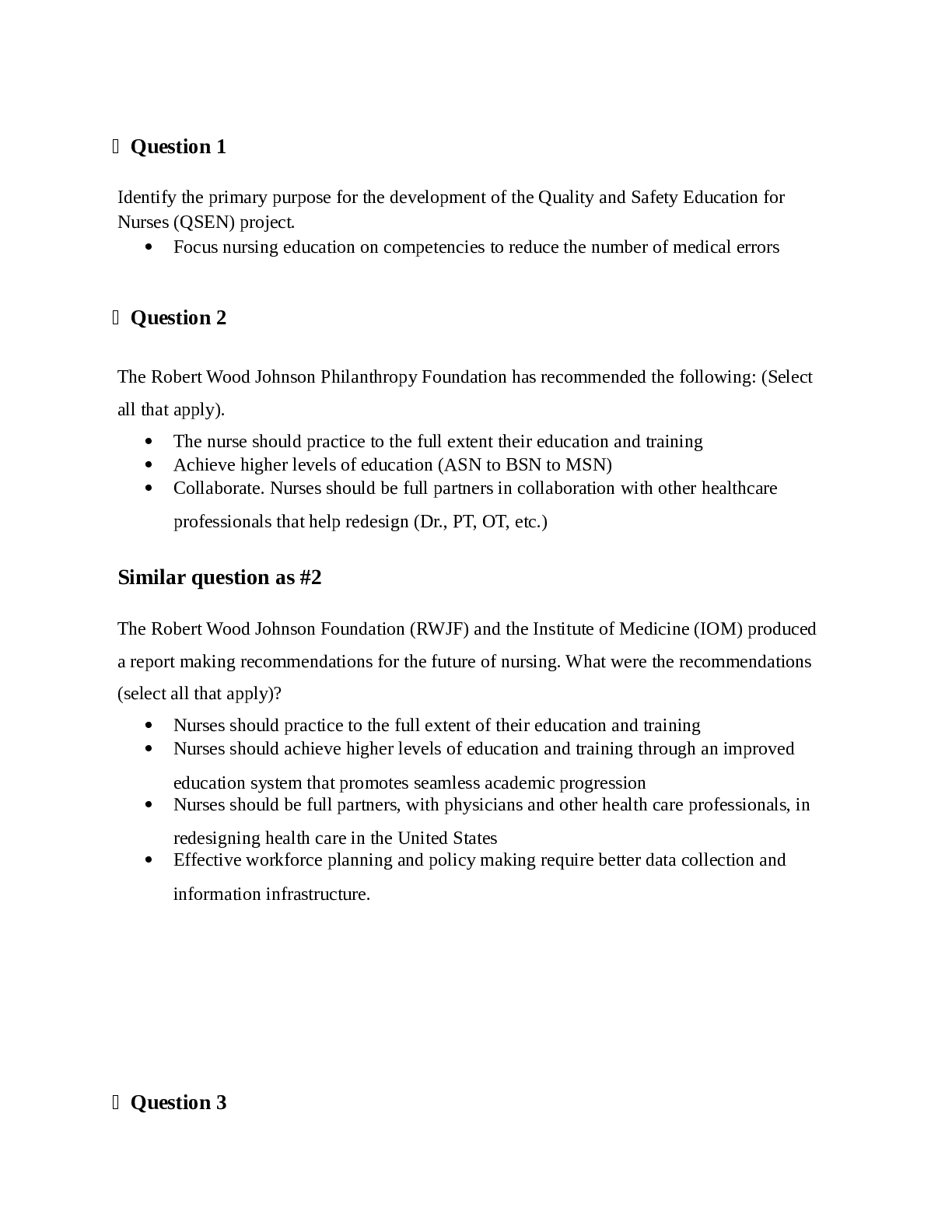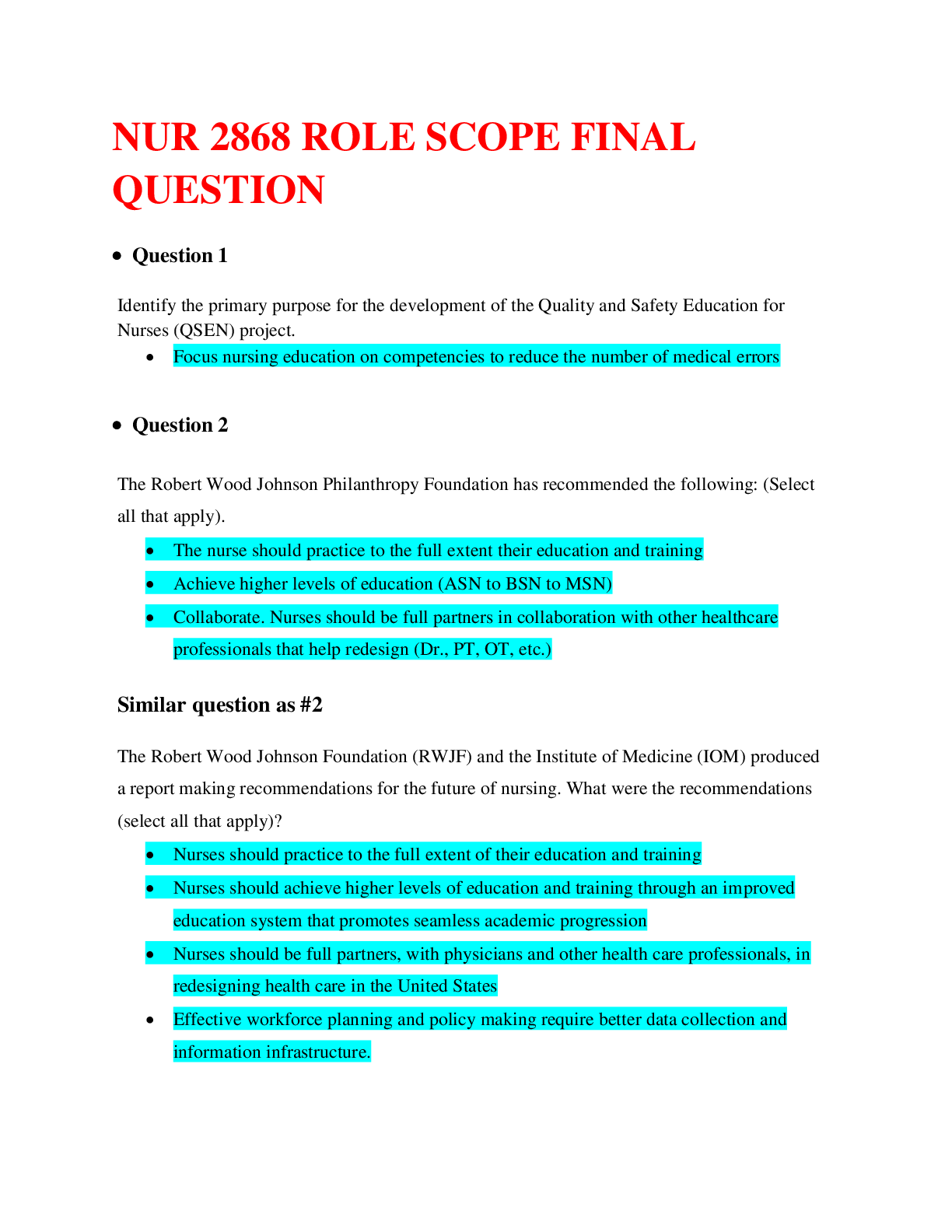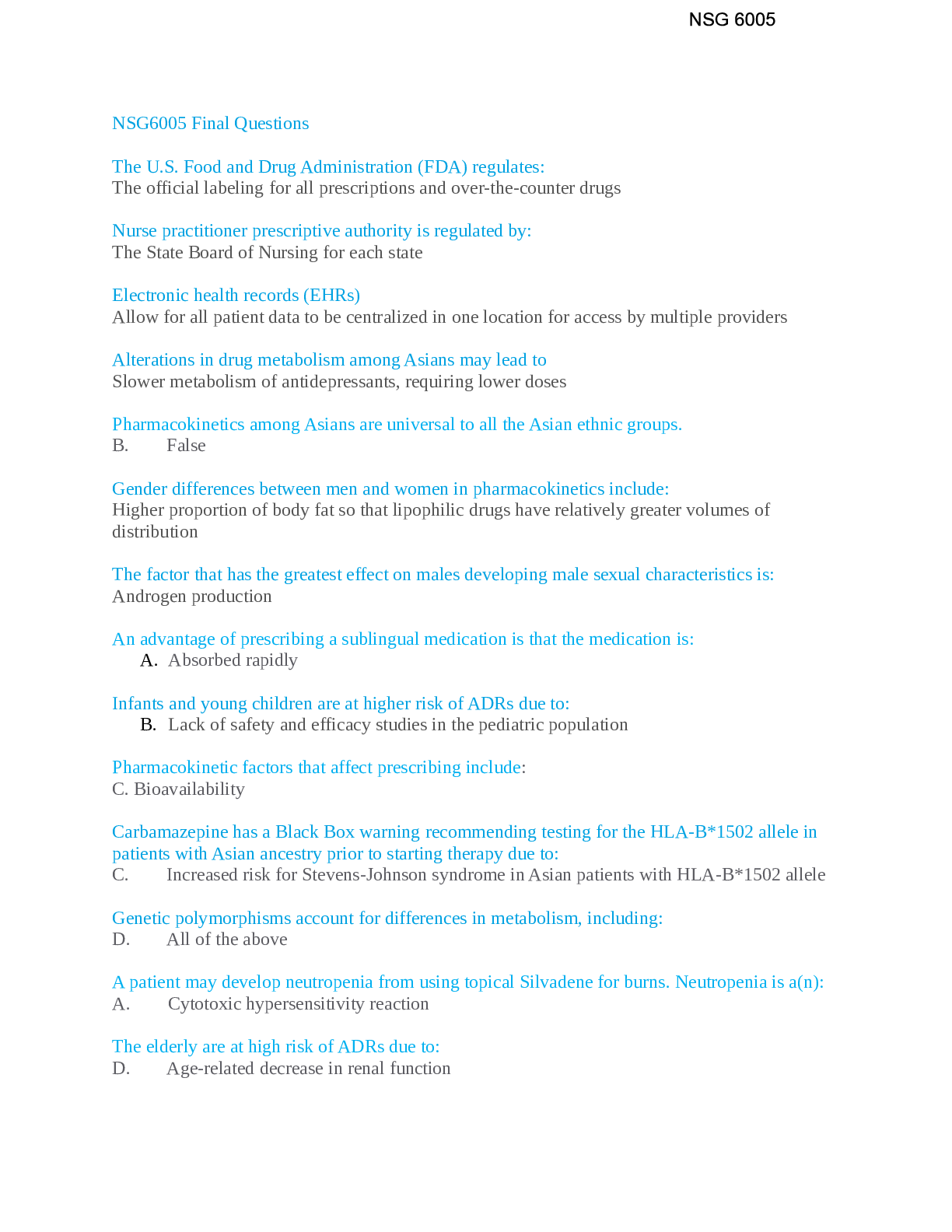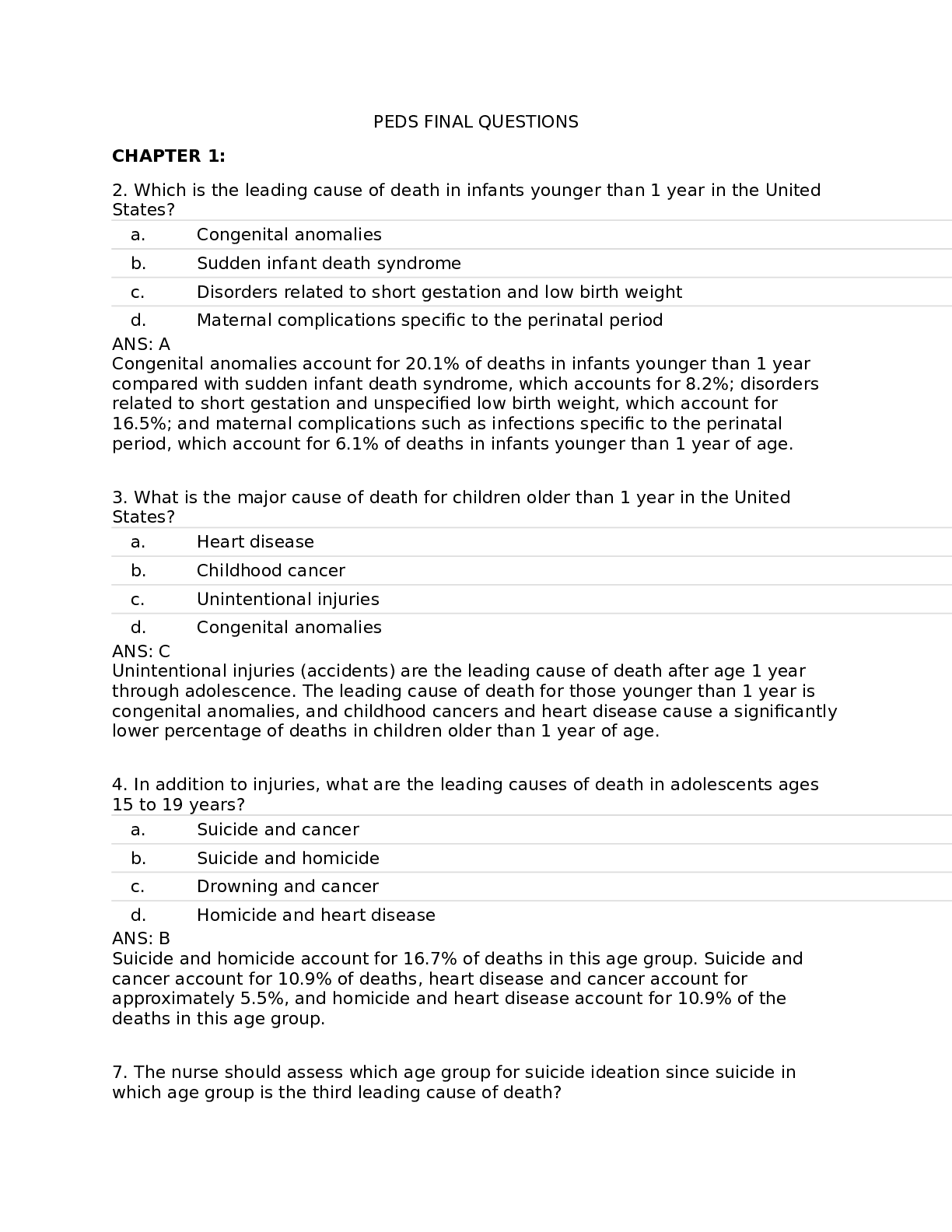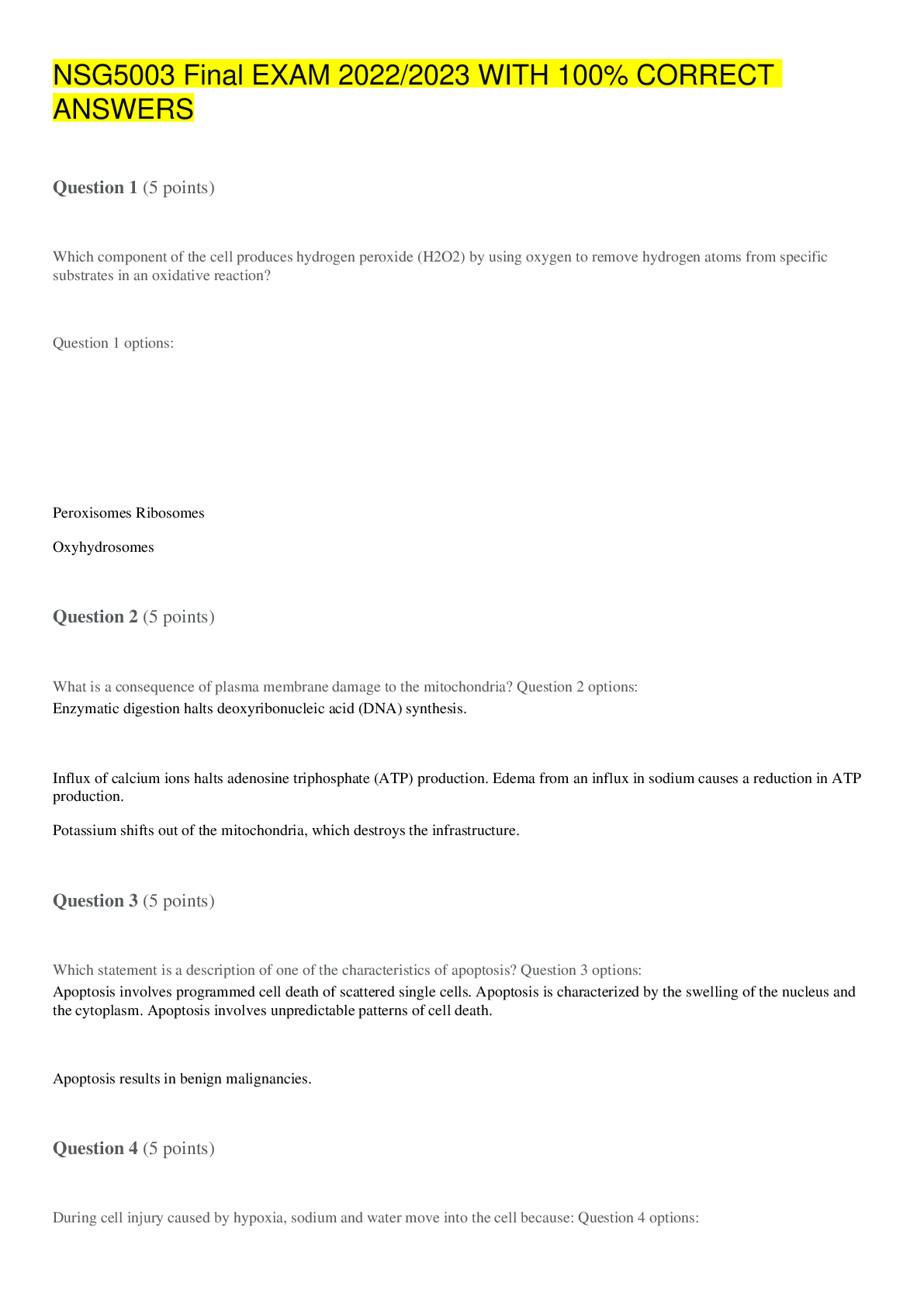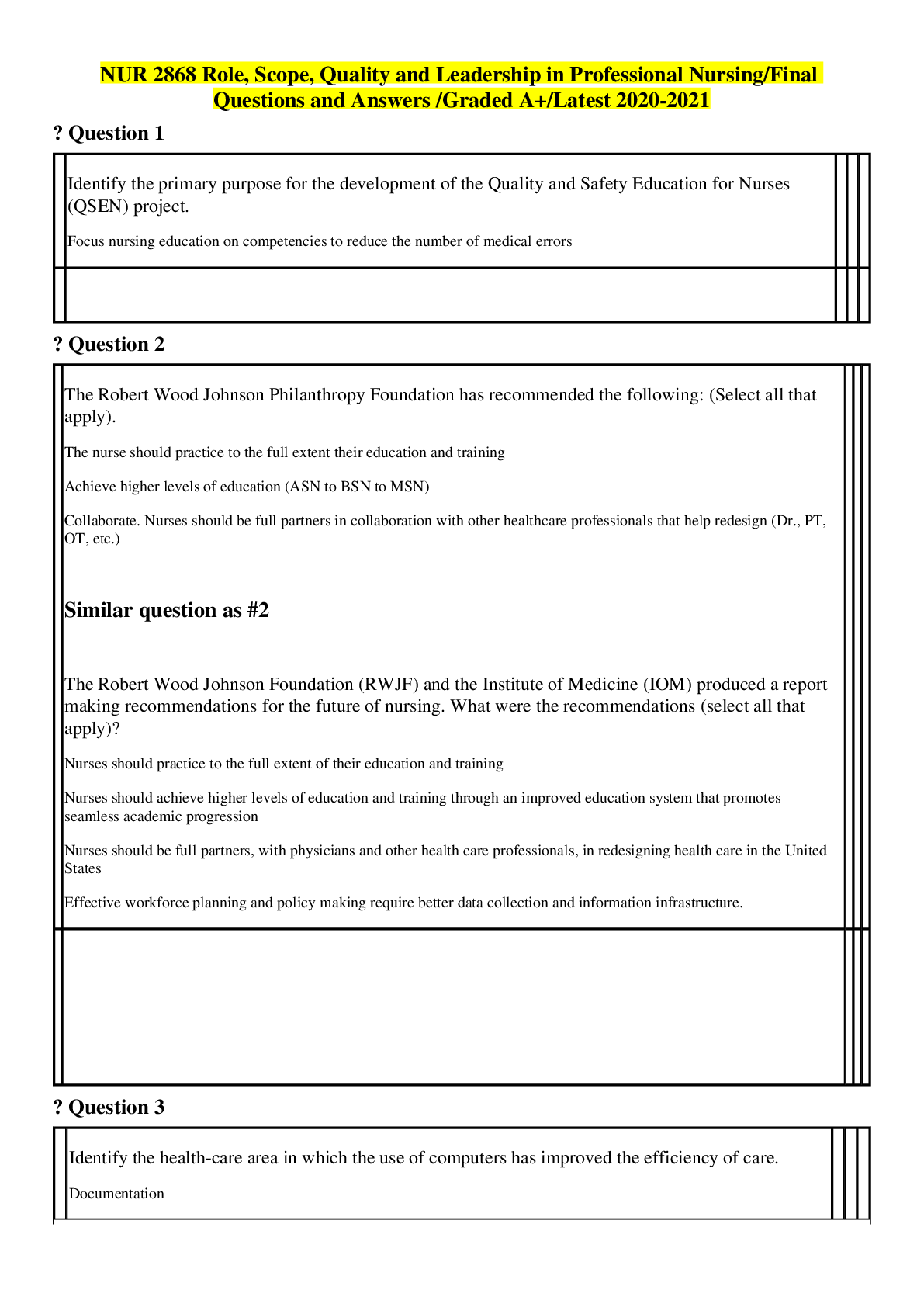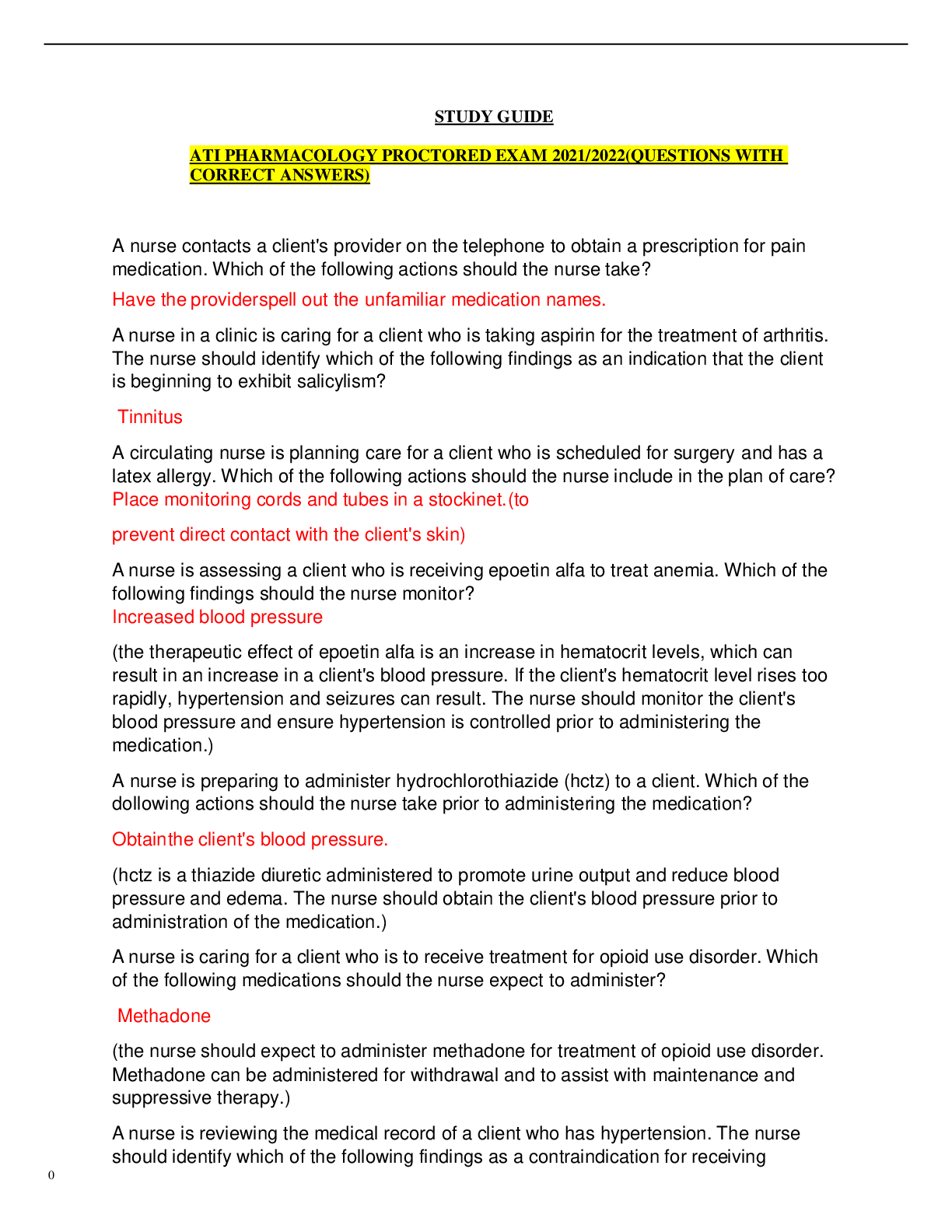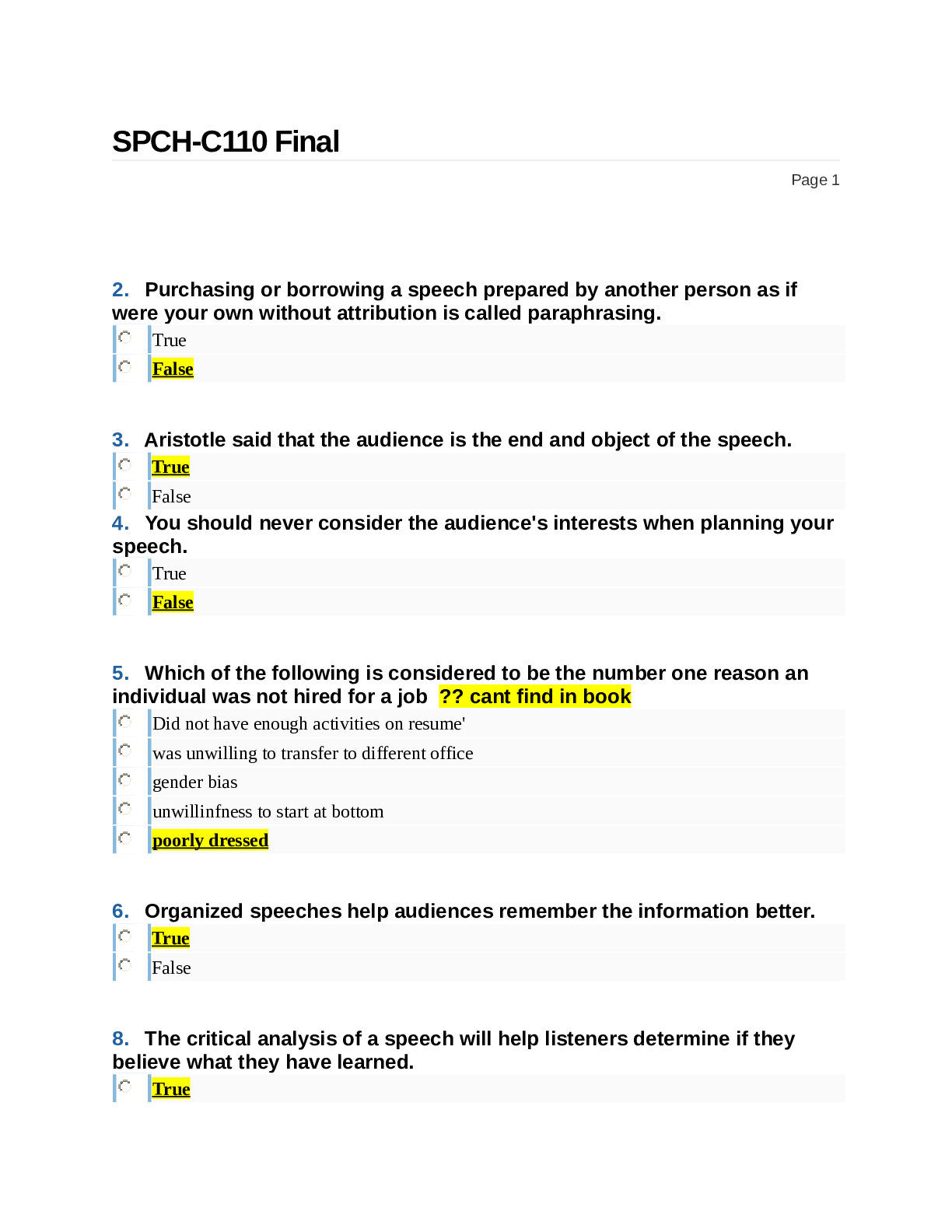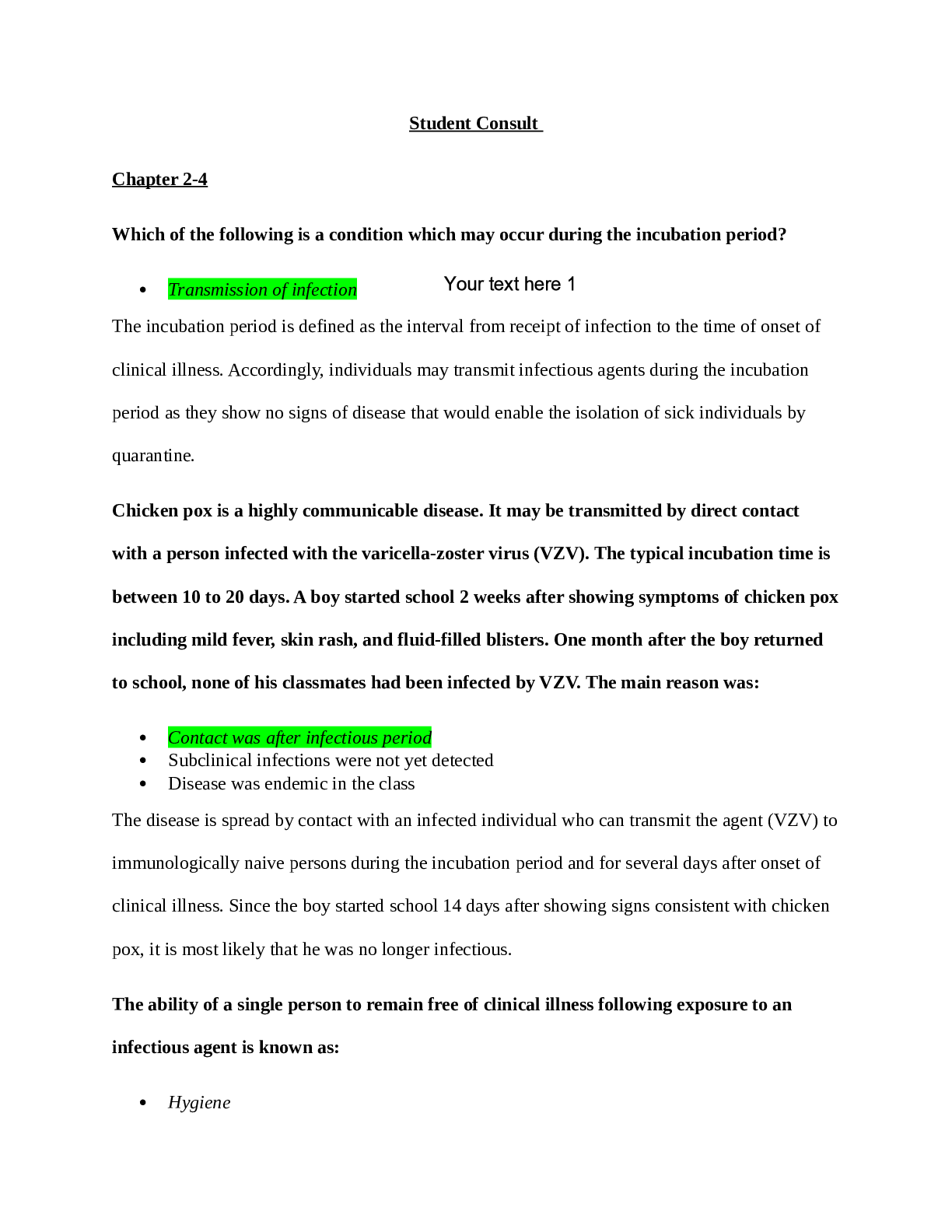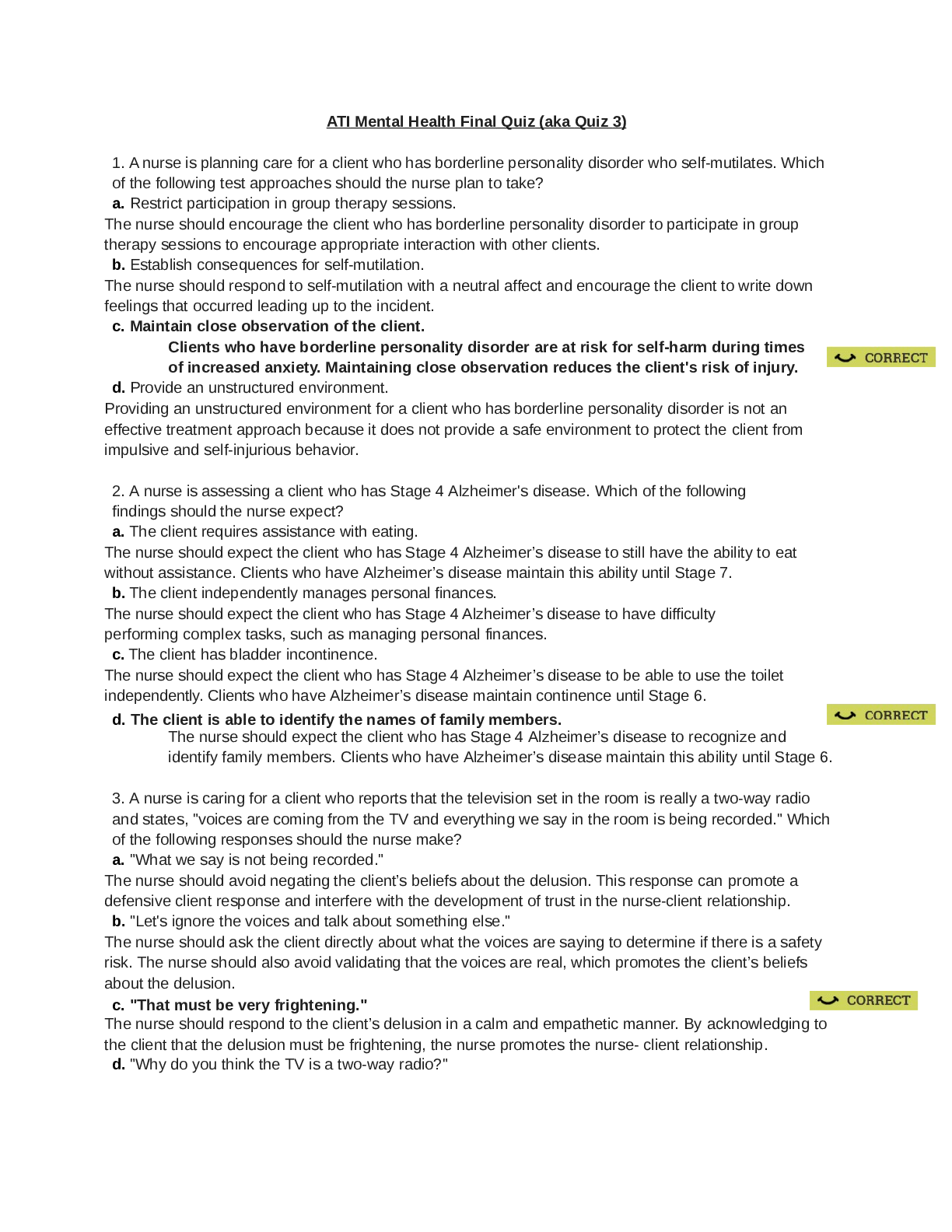NUR 108 Final Questions and Answers_ LATEST,100% CORRECT
Document Content and Description Below
NUR 108 Final Questions and Answers_ LATEST Question 1 1. The RN is caring for an older adult patient admitted with frequent falls at home. Which initial strategy is most effective to improve p... atient outcomes? a. Coordination of care with an interdisciplinary team. b. Maintain bedrest with close supervision. c. Prepare for transfer to skilled nursing facility. d. Frequent hospitalizations help to manage illness effectively. 1.25 points Question 2 1. Which of the following collaboratives has the mission to work with federal and state agencies to strengthen policies and practices with the outcome of making people healthier? a. Quality and Safety Education for Nurses b. Healthy People 2020 c. The Institute of Medicine d. American Association of Retired People 1.25 points Question 3 1. What is a fundamental component in Dorothy Johnson’s model of nursing? a. The role of adaptation in nursing care provided to the patient. b. The interpersonal aspect of nursing, the relationship between patients and nurses. c. The relationship between cultural factors and nursing practice. d. The behavior of the client is key to preventing illness and restoring health. 1.25 points Question 4 1. What is a benefit of the Affordable Care Act? a. Eliminates co-pays for preventative services. b. Increases administrative costs for insurance companies. c. Decreases Medicaid payments to primary care physicians. d. Financially rewards technology driven acute hospital based services. 1.25 points Question 5 1. A patient is preparing to sign an informed consent document to participate in nursing research. Which statement by the patient indicates additional teaching is necessary? “Signing this form protects the researcher from liability.” c. “I have the right to end my participation whenever I desire.” d. “Informed consent allows me to choose if I will participate.” 1.25 points Question 6 1. The RN is providing care for a hospitalized patient who states,”I don’t know what to do, I will never be able to manage my medications and appointments with all of these doctors. How will I ever do this?” The RN can consult with a nurse in which of the following roles to help this patient? a. Nurse coder b. Nurse navigator c. Forensic psychiatric nurse d. Nurse safety officer 1.25 points Question 7 1. An older adult patient with a newly diagnosed illness tells the RN, “It looks like I need to make peace with God.” What is the RN’s best initial response? “The clergy is much better trained to address your concerns.” c. “I believe in the power of prayer. Do you want me to pray with you?” d. “Are you distressed about your condition? Please tell me more.” 1.25 points Question 8 1. The RN who speaks up when a health care worker does not perform hand hygiene is upholding which ethical principle? a. Nonmaleficence b. Veracity c. Autonomy d. Justice 1.25 points Question 9 1. Which statement reflects the ethical principle of justice? a. Patients should be able to go to the physician of their choice. c. If a health care provider agrees to care for a patient, there is an obligation to follow through. d. Patients should be treated equally regardless of socioeconomic status. 1.25 points Question 10 1. The RN sees a coworker enter a patient’s room without wearing the necessary personal protective equipment (PPE) for transmission-based precautions.Which is the best response by the RN? a. “Not wearing the correct PPE is bad nursing practice.” b. “Appropriate PPE is essential to reduce the risk of health care infections.” c. “Your behavior is why we have so many infections on this nursing unit.” d. “I wear all the PPE if I am not touching the patient.” 1.25 points Question 11 1. Why are all health care workers who interact with the patient expected to participate in a patient centered team meeting? a. To provide the leader an opportunity to display expertise. c. To promote personal relationships with the team. d. To seek each member’s contribution to the plan of care. 1.25 points Question 12 1. The hospital is planning to implement a new bar code system for medication administration. Which statement describes the role of the RN to decrease medical errors? a. “I will ask to participate on the committee for bar code system design.” b. “A bar code system will eliminate the need for the RN to review medications.” c. “Training sessions should be optional for experienced nurses.” d. “I will learn to bypass the system during patient care emergencies.” 1.25 points Question 13 1. Which action by a health care worker demonstrates a potential violation of patient privacy information when using a computerized medical record? a. Posting a personal computer password in the nursing station. b. Using a privacy filter on computers that can be seen by others. Logging out of the computer screen when finished with documentation. d. Using institutional communication devices for work related issues. 1.25 points Question 14 1. The student nurse asks the RN the purpose of the patient satisfaction instrument called Hospital Consumer Assessment of Healthcare Providers and System (HCAHPS). Which is the best response by the RN? a. Reward the physicians with the lowest mortality rates. b. Establish preventative services. c. Identify staff who need remediation. d. Measure quality of care. 1.25 points Question 15 1. The RN is assembling a health care team to help coordinate care for a homeless adult who has a leg ulcer. Which team member must the RN include? a. Occupational therapist b. Physical therapist c. Social worker d. Client safety nurse 1.25 points Question 16 1. Which statement made during a meeting of a hospital’s ethics committee is based on the ethical principle of autonomy? a. The nurse agreed to be present when the patient talked to family about surgical treatment, however the nurse did not show up. b. This treatment is not appropriate for this patient because the danger of destroying the liver is greater than any potential beneficial effect. c. Patients have a right to refuse pain medication even when they admit to having severe pain. d. Costly treatment measures should not be prohibited for the elderly based on age. 1.25 points Question 17 1. A patient who is considering enrolling in a clinical research trial asks the RN “What would you do?” How does the RN respond in an ethical manner? a. “It is a difficult decision, we will support you in whatever you chose.” b. “The study offers you a hope of a cure, it would be worth a try.” d. “I would agree to be enrolled because the study will also help other people.” 1.25 points Question 18 1. Which statement by the RN reflects cultural sensitivity? a. “I treat people as I would want to be treated.” b. “I learned to speak another language.” c. “I am familiar with many different cultures.” d. “I ask each patient about practices to promote wellness.” 1.25 points Question 19 1. A patient awaiting surgery states “I chose the hospital for my surgery because it received high ratings on the internet.” What is the most appropriate response by the RN? a. “Tell me about the internet source you used for decision making.” b. “Make sure you always choose a recently updated website for this information.” c. “Social media sites are a good source of information about local hospitals.” 1.25 points Question 20 1. Which statement by the RN reflects an aggressive approach to conflict resolution? a. “It is not what I want, it is what the patient needs.” b. “I want to understand your position but it is still not clear to me.” c. “You need to follow my instructions exactly as I explained to you.” d. “We need to find a solution to this problem so that patient care doesn’t suffer.” 1.25 points Question 21 1. Which is an example of assertive communication by the RN during the interdisciplinary team patient care meeting? a. “The patient fell because he did not ask for help.” b. “We are here to seek ways to improve care.” c. “The intervention you are suggesting is wrong for this patient.” d. “The pharmacist needs to be reprimanded for delivering the meds late.” 1.25 points Question 22 1. The RN is meeting with a staff member to discuss recurrent late arrival for scheduled shifts. The staff member is highly animated and begins to explain multiple reasons for lateness. Which is the RN’s best response? a. “This behavior will not avoid the conversation. You need to be quiet and listen.” b. “You seem very upset. If you are on time in the future we can forget about this.” c. “You are lucky I am talking to you. Recurring lateness is grounds for dismissal.” d. “Please sit down and take a deep breath. We need to resolve this issue.” 1.25 points Question 23 1. The nurse manager solicits support from the nursing staff when preparing the unit budget. Which activities by the nursing staff assist with positive management of resources? Select all that apply. a. Promote self-care activities for all team members. b. Keep extra supplies in the patient’s room to save time. c. Delegate tasks to the appropriate health care worker. d. Prevent interruptions when administering medications. e. Use “down time” to have social conversations with peers. The RN assisting with a sterile dressing change sees a colleague contaminate sterile gloves. What action should the RN take? a. Quietly tell the colleague that another break in sterile technique will be reported. b. State the problem immediately and provide another pair of sterile gloves. c. Say nothing because the patient is receiving antibiotics. d. Ask the nurse manager to provide education about sterile technique for the unit. 1.25 points Question 25 1. An RN worked with a team of individuals to design a discharge process for patients, resulting in an improved discharge system. This is an example of which approach to problem-solving? a. Rapid response process b. Root cause analysis c. Leapfrog process d. Lean six sigma The RN is teaching the student nurse about the ANA Standards of Ethical Practice. Which statement by the student nurse indicates additional teaching is necessary regarding patient protection and impaired practice? a. Report all concerns regarding an impaired co-worker to the nursing supervisor. b. Assistance is available for impaired nurses from professional associations. c. Nurses who report impaired colleagues risk retaliation from the institution. d. Impaired nurses may return to practice after recovery. 1.25 points Question 27 1. Which is the primary reason that incivility among healthcare professionals presents a threat to patients? a. Incivility begins with impoliteness and leads to violence. b. Incivility creates additional stress in the health care environment. c. Incivility is linked to lower staff productivity. d. Incivility is associated with an increase in medical errors. A team of interdisciplinary personnel reviewed data regarding a sentinel event for surgery done on the wrong patient. The team was interested in looking at the events and systems that were related to this incident. Which approach is focused on identifying faulty systems and processes? a. Life-long learning culture b. Use of informatics c. Root cause analysis d. Benchmarking 1.25 points Question 29 1. The nurse manager asks clinic employees to participate in a nurse-led committee. The goal of the committee is to design and implement a plan addressing patient dissatisfaction with long wait times. What type of leadership is the nurse manager displaying? a. Democratic b. Laissez-faire c. Autocratic 1.25 points Question 30 1. What information does the RN include when explaining to a nursing student the advantages of being employed at a magnet hospital? a. The preferred leadership style in a magnet hospital is authoritative. b. Magnet hospitals have better benefit packages than non-magnet hospitals. c. Non-magnet hospitals always have low patient satisfaction scores. d. Magnet hospitals undergo an external review to document standards of nursing excellence. 1.25 points Question 31 1. Which statement by the RN demonstrates an understanding of the benefit of The Joint Commission accreditation? a. “Accreditation certifies increased staffing levels on the nursing units.” b. “Accreditation signifies the organization will be the best choice for clients to receive care.” c. “Accreditation validates efforts on quality improvement for client outcomes.” 1.25 points Question 32 1. A student nurse asks the RN about the legal authority to delegate tasks. Which statement describes why RNs have the legal right to delegate? a. American Nurses’ Association Standards of Practice allow legal delegation by the RN. b. Employment by an institution approved for operation by the state provides legal authority to delegate. c. RNs are licensed and governed by a statutory practice act which allows legal delegation. d. Completion of a specialized program of professional study allows the RN to legally delegate. 1.25 points Question 33 1. An RN on the quality improvement (QI) team at a healthcare institution recognizes which data is associated with The Joint Commission National Patient Safety Goals (NPSGs)? a. “One NPSG focuses on the number of health provider consultations.” b. “Patient satisfaction is one of the NPSGs.” c. “NPSGs include recommendations for unit staffing ratios.” d. “Types of medication errors are included in the NPSGs.” 1.25 points Question 34 1. A student nurse tells the RN “My patient’s blood pressure is 120/80, and blood pressure medications were administered one (1) hour ago.” This is an example of which component of informatics? a. Data b. Skill c. Information d. Knowledge 1.25 points Question 35 1. Which task can the RN delegate to an unlicensed assistive personnel (UAP)? a. Measuring oral intake and output for a geriatric patient. b. Obtaining a blood pressure on a patient experiencing dizziness. c. Showing a patient how to empty a wound drainage device. 1.25 points Question 36 1. Which organization provides hospitals with accreditation for the promotion of quality evidence-based measures to maximize health benefits? a. The Hospital Care Quality Information from the Comsumer Perspective (HCAHPS) b. The Leapfrog Group c. The Joint Commission (TJC) d. The Agency for Health Care Research and Quality (AHRQ) 1.25 points Question 37 1. The RN notices a new packaging for a medication resembles another medication that is commonly used. The RN calls the pharmacy and informs them of her findings. Which aspect of the patient safety program is the RN demonstrating? a. Continuous quality improvement b. Clinical pathway c. Quality indicator 1.25 points Question 38 1. A nursing student is discussing the benefits of nursing research with an instructor. Which statement indicates the student needs additional teaching? a. Research differentiates nursing as a profession through the use of a unique body of knowledge. b. Research provides empirical evidence to support nursing actions. c. Research enables quicker decision making by nurses. d. Research provides a means to implement improved ways to promote and maintain health. 1.25 points Question 39 1. What is one of the initiatives of The Leapfrog Group? a. Reward hospitals for high valued performance. b. Document medical errors not reported by organizations. c. Report nurses who deviate from standards of practice. d. Provide data to support hospitals from closing beds. 1.25 points Question 40 1. A nurse manager is fostering assertive behavior in the nursing staff. What is the best response by the nurse manager to an RN who states that an unlicensed assistive personnel (UAP) consistently leaves patient units untidy? a. "Plan to meet with me and the UAP; I will get back to you with the details by the end of the day.” b. “I will speak to the UAP but I need you to put the problem in writing.” c. “Please plan to bring up environmental clutter concerns at the next unit meeting.” d. “Discuss the issue with the UAP and see if the two of you can come up with a solution.” 1.25 points Question 41 1. During a unit meeting, nursing staff identifies a concern with the process of shift report. The nurse manager says “Fine, go ahead and do something else.” Which style of leadership is the nurse manager using? a. Laissez-faire b. Transformational c. Democratic d. Authoritarian 1.25 points Question 42 1. Which ethical principle is the nurse violating when the nurse tells a crying child, “If you don’t swallow this pill, I am going to give you a shot into your leg.”? a. Nonmaleficence b. Fidelity c. Obligation d. Justice 1.25 points Question 43 1. The RN is teaching a group of graduate nurses about clinical pathways. Which statement indicates additional teaching is needed? a. Clinical pathways allow monitoring of variances from prescribed plans of care. b. Clinical pathways encourage multidisciplinary documentation. c. Clinical pathways streamline the charting process. d. Clinical pathways eliminate the need for quality control activities. 1.25 points Question 44 1. Which nursing theory model helps direct nursing care for a patient at the end of life who is seeking inner harmony and spiritual meaning? a. Watson Model of Human Caring b. Roy Adaptation Model c. Orem Self Care Model d. King Model of Goal Attainment 1.25 points Question 45 1. An RN states, “I feel emotionally drained and physically sick after caring for some patients who receive aggressive treatments. It seems like we are only prolonging their dying process.” What is this RN experiencing? a. Work overload b. Disillusionment in nursing c. Moral distress d. Cultural shock 1.25 points Question 46 1. Which factors influence the number of RNs assigned to a patient care unit? Select all that apply. a. The type of management structure. b. Acuity of the patients. c. The access to resources by staff. d. The physical layout of the unit. e. Availability of ancillary support. 1.25 points Question 47 1. A 16-year-old with a chronic disease disagrees with parents regarding aggressive or palliative care treatment options. Which is the best response by the RN? a. “Your parents are ultimately responsible for making this decision.” b. “The ethics committee can assist with the decision-making process.” c. “It is best to rely on the decision by your healthcare provider.” d. “In my experience, aggressive care has the best results.” 1.25 points Question 48 1. A terminally ill patient who is considering withdrawal of treatment asks the RN if the family should be told. What is the next step in ethical decision making for the RN? a. Consult with a member of the ethics committee. b. Identify a physician who can write the necessary prescriptions. c. Discuss the patient’s feelings and concerns. d. Review the possible options of disclosure. 1.25 points Question 49 1. Which statement describes The Joint Commission (TJC)? a. Creates a national agenda to eliminate health disparities. b. Develops program outcomes for quality nursing education. c. Identifies elements to attract and retain professional nurses. d. Accredits an organization that provides high-quality service. 1.25 points Question 50 1. Which ethical principle is implicit in the statement “Provision of safe, competent care without patient harm is a healthcare provider’s duty.”? a. Nonmaleficence b. Veracity c. Autonomy d. Justice 1.25 points Question 51 1. Which patient would be most appropriate for the RN to assign to the LPN/LVN? a. A patient with a hip fracture who requires a blood transfusion. b. A newly admitted patient with pneumonia who needs a care plan developed. c. A patient who had a stroke and is awaiting transfer to a subacute facility. d. A patient with newly diagnosed diabetes mellitus who needs a home care referral. 1.25 points Question 52 A patient receiving home care is prescribed an analgesic medication that is twice the dose recommended by the manufacturer. Before administering the initial dose of the medication, what is the best response by the RN? a. Contact the prescribing provider for clarification of the dose. b. Inform the patient the dose might be lethal and can not be administered. c. Use nursing judgment and give half of the dose prescribed by the health care provider. d. Administer the dose as prescribed because it has been dispensed by a pharmacist. 1.25 points Question 53 1. Which nursing theory describes health as a person’s ability to adjust to health and illness along a continuum? a. Roy Adaptation Model b. Orem Self-Care Model c. Neuman Health-Care-Systems Model d. Johnson Behavioral System Model 1.25 points Question 54 Which elements must be included in a comprehensive risk management program? Select All that apply. a. Strategies to promote affordability of health care. b. Needs and preferences of patients. c. Multidisciplinary team membership. d. Focus on high-risk areas such as medication errors. e. Safety needs of patients, staff, and visitors. 1.25 points Question 55 1. A student nurse asks the RN to explain the term “just culture” in healthcare. Which concept is included in the RN’s response? a. Mutual respect among health care professionals. b. Blame-free, proactive approach to human error. c. Equal pay for equal work. d. Elimination of ethnic bias. 1.25 points Question 56 regarding the prevention of pressure ulcers? a. Experimental b. Meta-analysis c. Survey d. Descriptive 1.25 points Question 57 1. What is an advantage of the telehealth technology? a. Minimizes liability issues for the caregiver. b. Requires minimal preparation for health providers and patients. c. Allows healthcare providers to treat patients from distant sites. d. Costs are fully covered by private health care insurance. 1.25 points Question 58 1. The RN is participating in a community forum on Health Care reform and is asked to comment on the projected impact of the Affordable Care Act for the profession of nursing. Which elements would the RN include in the response? Select all that apply. a. Heightened demand for RNs in specialty fields such as informatics and case management. b. Greater need for RNs to care for an increased number of persons seeking health care. c. Increased use of Advanced Practice Nurses in the acute care and primary care settings. d. Development and implementation of new nursing roles. e. Bolster the power of the American Nurses Association as a result of requirement for employment. 1.25 points Question 59 1. Which task is appropriate for the RN to delegate to an LPN? a. Monitor a newly admitted patient with acute heart failure. b. Teach a patient’s spouse how to cleanse and dress a wound on the posterior thigh. c. Assess the function of a newly inserted intestinal tube. d. Provide stoma care for a patient with an established colostomy. 1.25 points Question 60 The homecare RN is coordinating care for a chronically ill patient. Which task can be delegated to the unlicensed assistive personnel (UAP)? a. Teach family to administer pain medication orally. b. Auscultate lung sounds and report abnormals to the RN. c. Evaluate gait and the potential need for a walker. d. Assist with bathing during every visit. 1.25 points Question 61 1. An unlicensed assistive personnel (UAP) says “I am not sure I calculated the intake and output correctly, but I know the nurse is always responsible.” Which is an appropriate response by the RN to the UAP? a. “When you agree to perform a task, you are responsible for your actions in carrying it out.” b. “You are working under the RN's license when you accept responsibility for this task.” c. “UAPs can not record intake and output, you should not have done those tasks.” d. “The RN does not need to supervise tasks that are within the UAP job description.” 1.25 points Question 62 A patient with end stage heart disease is seeking a heart transplant. What ethical principle supports the eligibility criteria that reviews the patient’s history of adherence to the medical treatment plan? a. Beneficence b. Distributive justice c. Veracity d. Autonomy 1.25 points Question 63 1. Which nurse would best assist a patient diagnosed with breast cancer requiring radiation and chemotherapy? a. Forensic nurse b. Nurse navigator c. Client safety nurse d. Nurse researcher 1.25 points Question 64 1. A child of a person with Alzheimer’s dementia asks the RN about obtaining a genetic test process does the RN explore personal bias about the issue? a. Planning b. Diagnosis c. Assessment d. Evaluation 1.25 points Question 65 1. The RN is returning to work after placing a family member in Hospice care. Which response should the RN use when a terminally ill client asks, “Should I sign a do not resuscitate order?” a. “If you would like to seek spiritual counseling, I can call pastoral care.” b. “This is a difficult situation; what are your views on end of life care?” c. “I would choose not to be resuscitated, too.” d. “I just put my mother in Hospice care with a do not resuscitate order.” 1.25 points Question 66 1. A patient requires transfer to a long term nursing care facility after an extended acute care family with the process? a. Bedside nurse b. Client safety nurse c. Nurse manager d. Nurse care coordinator 1.25 points Question 67 1. The RN is participating in multidisciplinary rounds. Which outcomes address conflict management in this collaborative environment? Select all that apply. a. Teamwork and harmony is enhanced. b. Support and respect for the team is demonstrated. c. Opportunity to understand another’s point of view is provided. d. Minimal time and resources are expanded. e. A win/win agreement is potentially produced. 1.25 points Question 68 A patient care area has noticed an increase in the number of patient falls. Which risk management process tracks events and develops a plan to prevent similar events from happening? a. Performing a root cause analysis. b. Completing an incident report. c. Reviewing evidence-based practice. d. Using the unit based tracking systems. 1.25 points Question 69 1. Which element of health care reform provides the greatest opportunity to reduce health care costs? a. Insurance recission b. Organization accreditation c. Electronic health record d. Experience rating systems 1.25 points Question 70 Which of the following is a contributing factor to the higher patient mortality rates in the United States as compared to other developed countries? a. Diversity of the population. b. Aging of the population. c. Limited access to healthcare. d. Population density. 1.25 points Question 71 1. A student nurse asks an RN “What strategies are useful when faced with an ethical dilemma in professional practice?” How does the RN respond? Select all that apply. a. “I consult the ethics committee when the problem is complex.” b. “I use the Nursing Code of Ethics for guidance.” c. “I defer to the healthcare provider to make the correct decision.” d. “I use the nursing process to organize my thought process.” e. “I focus on myself and what I would I do if faced with the issue.” 1.25 points Question 72 criteria for the article will provide the best information for evidence-based practice? a. Journal article published six (6) years ago. b. Research based article addressing gap in knowledge. c. Data published by a healthcare provider on social media. d. Case study based on an unusual patient situation. 1.25 points Question 73 1. What does the RN anticipate as a societal health care need in the future? a. Growth in the aging population. b. Expansion of acute care capacity. c. Increase use of task orientated nurses. d. Paternalistic approach to the plan of care. 1.25 points Question 74 1. An RN is assessing a patient when the patient suddenly becomes confused and anxious. Which resource is most important for the RN to contact? Rapid response team. b. Resuscitation team. c. Risk management team. d. Security response team. 1.25 points Question 75 1. Which of the following is an example of a quantitative research design? a. An experimental study assessing medication effectiveness. b. Interviews to learn about ethnic heritage and traditions. c. Historical research on the role of nursing during the American Revolution. d. A case study describing a patient’s medical situation and care. 1.25 points Question 76 1. A patient refused to receive blood products based on religious beliefs. The patient had unexpected blood loss during surgery. Which action by the healthcare team is consistent with patient autonomy? a. Encourage the family to agree to a do not resuscitate order. c. Convince the family that administering blood is the right thing to do. d. Aggressively treat the patient with therapies that exclude blood products. 1.25 points Question 77 1. A student nurse asks the RN “Is there anything special to consider when teaching prevention strategies to the older adult?” What is the best response by the RN? a. “The chronically ill older adult may have limitations that require special teaching methods.” b. “Older edults are less likely to be interested in learning new things.” c. “Older adults are less likely to be interested in learning new things.” d. “The nursing educational plan is the same for all adults regardless of age.” 1.25 points Question 78 1. A patient with no health care directives is admitted to the hospital with a devastating stroke. The family asks the RN about options regarding resuscitation efforts. What is the RN’s best initial response? a. “It is too early to make this decision.” c. “Gather your family to make the best decision.” d. “What do you think the patient would want done?” 1.25 points Question 79 1. Which action by the RN is supported by the 2015 ANA Code of Ethics? Select all that apply. a. Collaborate with others to promote health initiatives. b. Accept accountability for delegation of nursing activities. c. Address patient needs as the priority before personal duties. d. Participate in scientific inquiry to advance nursing practice. e. Advocate for patient rights. 1.25 points Question 80 1. An LPN is assigned to care for a patient who suddenly develops acute respiratory distress. What is the most appropriate action by the charge RN? a. Monitor the LPNs ability to handle patient needs and reassign only if needed. b. Assign the LPN’s other patients to different nurses within the team. c. Assign an unlicensed assistive personnel (UAP) to help the LPN with patient care. d. Assign an RN to the LPN’s patient and reassign the LPN. 1.25 points [Show More]
Last updated: 1 year ago
Preview 1 out of 79 pages
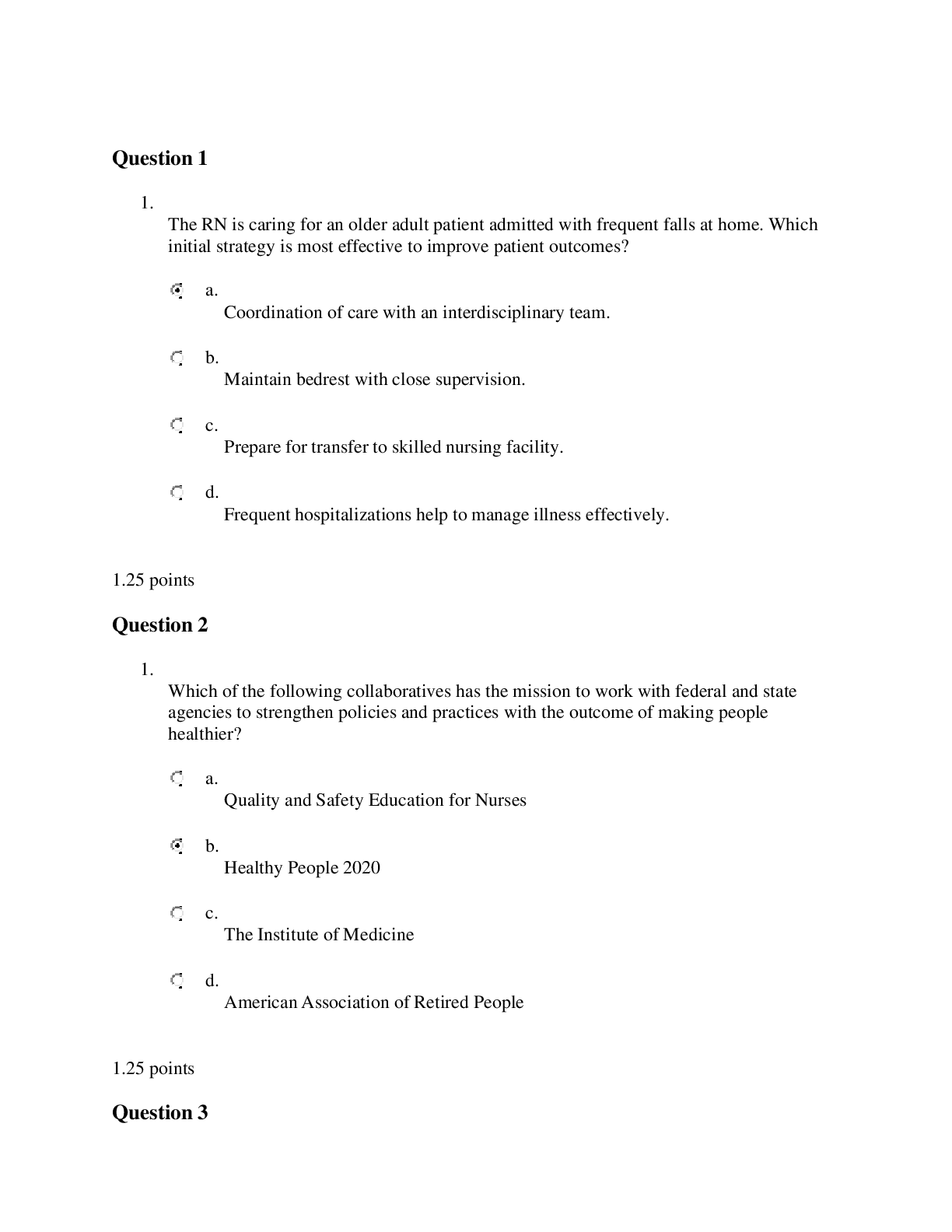
Buy this document to get the full access instantly
Instant Download Access after purchase
Add to cartInstant download
We Accept:

Also available in bundle (1)

NUR 108 final 1&2 Questions and Answers_LATEST 100% CORRECT
NUR 108 Final Questions and Answers_ LATEST NUR 108 final 2 Questions and Answers
By securegrades 2 years ago
$25.5
2
Reviews( 0 )
$16.00
Document information
Connected school, study & course
About the document
Uploaded On
Oct 13, 2021
Number of pages
79
Written in
Additional information
This document has been written for:
Uploaded
Oct 13, 2021
Downloads
0
Views
46













